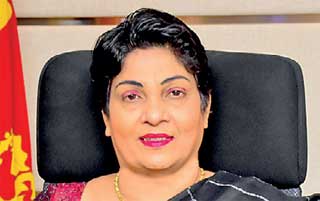Saturday Nov 29, 2025
Saturday Nov 29, 2025
Monday, 30 August 2021 03:33 - - {{hitsCtrl.values.hits}}
 |
| NSB Chairperson Keasila Jayawardena |
 |
| NSB GM CEO Ajith Peiris
|
Recording its highest-ever profit for a period of six months with a Profit Before Tax (PBT) of Rs. 13.9 billion and a Profit After Tax (PAT) of Rs. 11 billion, National Savings Bank (NSB) shows strength and financial resilience in performance amidst the heightened uncertainty due to the COVID-19 pandemic which has triggered a wide range of shocks on the banking sector and the economy as a whole.
Against the backdrop of the COVID-19 impact on the economic activities, the PBT for the first six months of 2021 was Rs. 13.9 billion, which marks an increase of 492.1% from Rs. 2.3 billion recorded in the same period last year, while the PAT was Rs. 11 billion, with an increase of 942.7% from Rs. 1.1 billion in 2020.
Gross Income of the bank grew by 9.3% to Rs. 65.8 billion during the first six months of the year from Rs. 60.2 billion recorded in the corresponding period, last year.
During the period under review, the interest income has increased by 8.5% to reach Rs. 64.1 billion, while the interest expense has decreased by 18.8% to Rs. 37.9 billion due to the prevailing lower interest rate regime which leads to lower interest expenses for the deposits as well as borrowings despite the substantial growth in the deposit base during the first half of the year.
The increase in interest income together with the considerable reduction in interest expenses supported Net Interest Income (NII) to surge by 111.7% to Rs. 26.2 billion against Rs. 12.4 billion stood during the same period last year. Consequently, Net Interest Margin (NIM) clocked in 3.70% at the end of first six months of 2021, higher against the 2.08% as at the same period last year.
Net Fee and commission income grew by 175.4% to Rs. 1.3 billion from Rs. 467 million mainly driven by the increase in fee and commission income due to conversion/renewal of the existing loans to reduced interest rates as well as increased foreign remittances and coupled with fees generated through digital platforms to where the customers shifted under social distancing and health guidelines.
The increase both in NII and Non-Interest Income led the total Operating Income to record a rise of 107.4% to Rs. 27.8 billion during the first six months of the year.
Operating expenses during the period of first six months of 2021, rose by 22.7% to Rs. 9.5 billion compared to the corresponding period of the previous year, which is mainly attributable to the increased personnel expenses owing to the provisions made for the Collective Agreement due in 2021. Meanwhile, the bank’s cost to income ratio decreased to 34.3% at the end of 1H 2021 compared to 57.8% reported in the 1H 2020.
Even though the NPL increased during the first half of 2021, its rise during the period was relatively lower compared to 1H 2020. This led to the Impairment charges during the period under review to decrease to Rs. 1.4 billion by 38.0% compared to the same period in the last year.
The bank has carried out a prudent approach when calculating the impairment charges, considering that the outbreak of COVID-19 has caused disruption in business and economic activities, along with the uncertainty and volatility prevailing in the global and local economy and other holistic factors. However, the gross NPL ratio increased to 3.16% mainly owing to the reclassification of some loans and advances under debt and other instruments.
The bank generated a Return on Equity (RoE) of 37.6% and Return on Assets (RoA) of 1.96% at the end of June 2021. The total asset base of the bank grew at 9.2% to reach Rs. 1.49 trillion against the Rs. 1.36 trillion reported as at the end of December 2020 mainly contributed by the growth in customers’ deposits, which increased by 9.3% to Rs. 1.35 trillion compared to the deposit base reported at the end of December 2020.
There is an increase in the pattern of saving of the customers despite the impact of COVID-19 on the economy and lifestyle of the customers.
During the first six months of the year, the bank has mobilised Rs. 118.1 billion worth of deposits which recorded an increase of 23.8% compared to the same period last year. The bank continued the momentum of mobilising low-cost funds during the period under review by mobilising Rs. 30.4 billion savings deposits which improved the deposit mix by 22 bps compared to December 2020.
Loans and advances witnessed a decline of 2.5% to Rs. 504.1 billion over the last year December figure of Rs. 516.8 billion underpinned by the conversion of Rs. 59.4 billion loans and advances under the ‘Debt Instruments’. However, without taking the converted loans into consideration, the total loans and advances demonstrated a growth of 10.2%, triggered by personal loans as well as loans to State Owned Enterprises (SOEs).
Complying with the direction of the Central Bank of Sri Lanka (CBSL), the capital position of the bank remained strong and stood well above the revised minimum statutory requirements imposed by the regulator consequent to the COVID-19 pandemic.